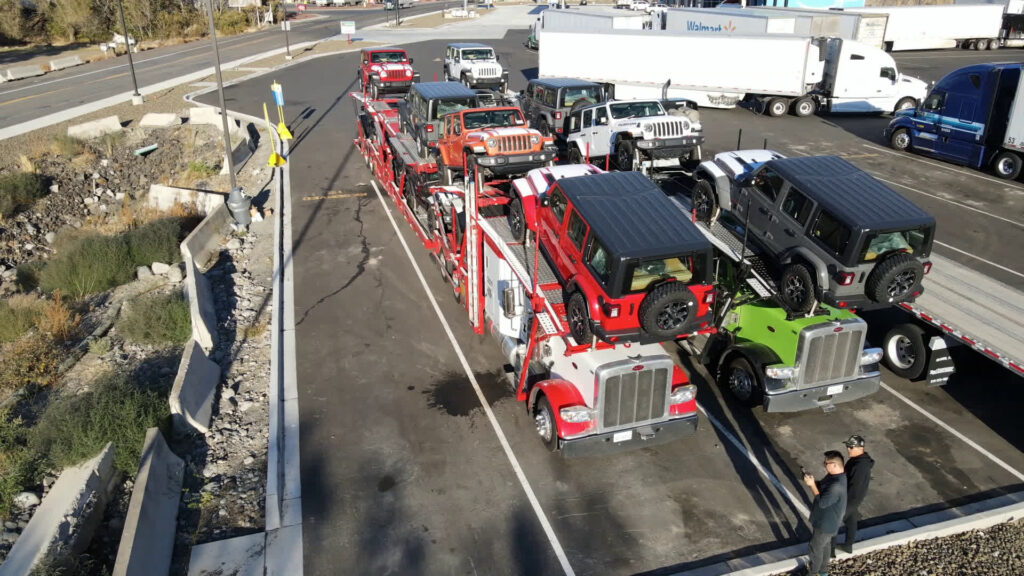Welcome to the exciting world of automotive transportation! Have you ever wondered how those shiny new cars make their way from the factory to your local dealership? It’s a fascinating journey that involves meticulous planning, strategic logistics, and a whole lot of horsepower. From bustling ports to sleek showrooms, this blog post will unveil the behind-the-scenes process of transporting brand new cars to dealerships. So buckle up and get ready for a ride through the intriguing world of automotive shipping!
How are brand new cars shipped?
When it comes to shipping brand new cars, there are several methods that manufacturers and dealerships rely on to get those wheels rolling. One common method is through the use of car carriers or transport trucks specifically designed for hauling vehicles. These massive trailers can carry multiple cars at once, securely fastening them in place to prevent any damage during transit.
Another option is shipping vehicles by rail. Rail transportation offers a cost-effective and efficient way to move large quantities of cars over long distances. Car manufacturers often have dedicated train services that transport their vehicles from production plants to various distribution centers across the country.
For overseas shipments, car manufacturers utilize cargo ships equipped with specialized car decks. These decks are designed with adjustable ramps and secure tie-downs to ensure that each vehicle stays in place throughout the voyage. Upon arrival at the port, the cars are carefully unloaded and prepared for their onward journey via road or rail.
In some cases, depending on distance and logistics, new cars may be flown directly from manufacturing plants to dealerships using cargo planes. This method allows for faster delivery times but is typically reserved for high-end luxury vehicles or limited-edition models where speed is of utmost importance.
Regardless of the shipping method used, one thing remains constant: meticulous attention to detail and careful handling are paramount when transporting brand new cars from factory floors all the way into showrooms around the world.
How long does it take for a car to be delivered to the dealership from the port?
When it comes to getting a brand new car from the port to the dealership, timing is everything. Car manufacturers and shipping companies work together to ensure that the transportation process runs smoothly and efficiently. But how long does it actually take for a car to be delivered from the port to the dealership?
The duration can vary depending on several factors such as distance, weather conditions, customs clearance procedures, and logistics arrangements. On average, it can take anywhere between a few days to a couple of weeks for cars to reach their destination.
Once the cars arrive at the port, they are unloaded from the carriers and undergo thorough inspections. This includes checking for any damages or defects during transit. After inspection, they are then loaded onto transport trucks or railcars for further distribution.
From there, the time it takes for delivery largely depends on the distance between the port and the dealership. If they are in close proximity, delivery might occur within a few days. However, if they are located far apart or in different states or countries altogether, it may take longer due to necessary paperwork and coordination with multiple parties involved.
Efficiency is key in this process as car dealerships strive to have fresh inventory available for customers as soon as possible. Therefore, manufacturers and shipping companies continuously work towards minimizing delays and optimizing transportation routes.
In conclusion, the journey of a new car from the factory to the showroom involves careful planning and coordination at every stage of transportation. While various factors influence delivery timescales, all parties involved make efforts to streamline processes so that customers can enjoy their shiny new vehicles without unnecessary delays.
How can I track a car in transit to a dealership?
Tracking a car in transit to a dealership can be an exciting and nerve-wracking experience. After all, you have been eagerly waiting for your shiny new vehicle to arrive! Fortunately, with modern technology, tracking your car’s journey has become easier than ever before.
One way to track your car is through the shipping company or logistics provider handling the transportation. They usually provide a tracking number or reference code that allows you to monitor the progress of your vehicle online. This tracking system gives you real-time updates on its location and estimated time of arrival at the dealership.
Another method is through the manufacturer’s website or mobile app. Many automakers offer this feature as part of their customer service package. By entering your order details or VIN (Vehicle Identification Number), you can access information about when your car left the factory, its current location during transit, and even receive notifications about any delays or changes in the delivery schedule.
In addition to these options, some dealerships may also have their own tracking systems where they keep customers informed about their cars’ status. You can simply give them a call and inquire if they have any updates regarding your vehicle’s journey.
Regardless of which method you choose, being able to track your new car while it makes its way from the factory to the showroom adds an extra layer of excitement and anticipation. It allows you to stay connected with every milestone until that moment when it finally arrives at the dealership ready for pickup!
So go ahead and utilize these tools available at your fingertips! Track away and delight in knowing exactly where your new pride-and-joy is on its thrilling voyage home!
How are cars usually shipped?
In the world of automotive transportation, ensuring that brand new cars are delivered safely and efficiently to dealerships is a complex process. From the factory to the showroom, every step in the journey plays a crucial role in getting these shiny vehicles into the hands of eager customers.
So, how are new cars transported to dealerships? The answer lies in various shipping methods tailored to meet the demands of this industry. Let’s take a closer look at how cars usually make their way from point A to point B.
One common method used for transporting new cars is by rail. Trains offer an efficient and cost-effective solution for moving large numbers of vehicles over long distances. Specialized car carrier wagons securely hold multiple cars, ensuring they arrive at their destination unscathed. This mode of transport allows for streamlined logistics and reduces road congestion, making it an environmentally friendly choice indeed!
Another popular option is shipping via enclosed trailers or car carriers on highways. These trucks can carry multiple vehicles simultaneously, protecting them from external elements during transit. With skilled drivers behind the wheel, these rigs navigate through various routes and deliver shipments directly to dealership lots across different regions.
For overseas shipments, especially when importing or exporting vehicles from distant countries or continents, sea freight comes into play. Cars are carefully loaded onto cargo ships using specialized equipment designed specifically for vehicle transportation. Once secured inside containers or Ro-Ro (roll-on roll-off) vessels, they embark on a voyage across vast oceans until reaching port destinations.
Air freight is also utilized when time is critical and there’s an urgent need for delivery, perhaps unveiling that highly awaited model at an international auto show! While expensive compared to other options due to limited capacity onboard planes, it ensures swift transportation thanks to its ability to bypass road traffic and maritime delays.
Regardless of the chosen mode of transportation, whether it be by rail, highway trucking services, sea vessels, or even air travel, a well-coordinated network connects all these dots along with the support of logistics experts. They ensure that vehicles are loaded and unloaded with precision.
Pros:
– Cost-effective solution for getting new cars to dealerships quickly and safely
– Allows dealerships to stock up on new cars quickly and efficiently
– Reduces the need for having new cars shipped by rail or truck
– Can reduce emissions associated with car transport
– Can help to reduce traffic congestion on roads
Cons:
– Can be costly for dealerships depending on the size and distance of the shipment
– Can be difficult to coordinate with multiple dealerships
– Can be time consuming to arrange shipping details for each shipment
– Could lead to potential delays in delivery due to weather or other factors
– Could lead to potential damages to the car during transport if not properly secured
FAQs:
1. How do new cars get to the dealership?
Answer: New cars are typically transported from the manufacturer to dealerships via enclosed car carriers or railcars.
2. How long does it take for a new car to arrive at the dealership?
Answer: The time frame for delivery can vary, but most manufacturers aim for an average of 10-14 days from the time the car leaves the factory until it arrives at the dealership.
3. Are new cars inspected before they reach the dealership?
Answer: Yes, all cars must pass a rigorous inspection process by the manufacturer before they are allowed to be shipped to dealerships.
4. Does shipping a new car cost extra?
Answer: Most dealerships will include the cost of shipping in the negotiated price of the car.
5. Is there tracking information available for new cars in transit?
Answer: Yes, auto dealerships have access to tracking information that can provide updates on the location and estimated time of arrival.
Features:
– New cars are transported safely and securely to dealerships.
– The cars are delivered on specialised car transporters, which are designed to keep the cars safe during transit.
– The transporters are usually equipped with air bag suspension systems, which provide additional cushioning to protect the cars from bumps and vibrations during the journey.
– The car transporters are also fitted with climate control systems, which help to keep the cars at a comfortable and consistent temperature during transport.
– The cars are secured securely to the transporter to ensure they don’t move during the journey.
– The transporters are often equipped with GPS tracking systems, allowing the dealerships to track the progress of the shipment.
– The transporters are usually covered and waterproof to protect the cars from the rain and other weather conditions.
– The cars are usually unloaded at the dealership by the transporter’s crew, who are highly trained and experienced in safely and securely moving cars.

